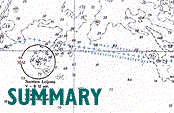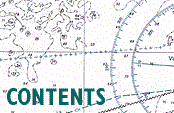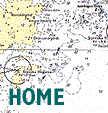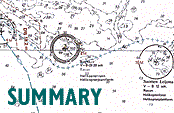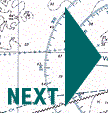 |
From about 1960 the ro-ro ferry traffic between south-west Finland and the Stockholm region in Sweden developed extraordinarily fast regarding number of ships built for the trade, their increase in size, capacity and comfort and the number of passengers and vehicles carried. The development was spurred by the competition between the two major shipping company groups engaged in the trade, Viking Line and Silja Line, both under mixed Finnish and Swedish ownership. In several respects it probably progressed faster than international regulations and the classification societies could accommodate. The rate of development during the 1970s and 1980s has generally been considered to lack equivalence in any comparable trade.
 Understanding of this development has been considered important for appreciation of the overall circumstances of the ESTONIA accident. A separate study of the history of this ferry traffic was therefore commissioned from a consultant company, ADC Support AB. The study is included in the Supplement. Understanding of this development has been considered important for appreciation of the overall circumstances of the ESTONIA accident. A separate study of the history of this ferry traffic was therefore commissioned from a consultant company, ADC Support AB. The study is included in the Supplement.
|
 |
 |
Scheduled steamer traffic has long existed between Helsinki and Stockholm. Passenger and cargo services were generally separate. A small number of cars could be carried on the steamers, being lifted on board in the traditional manner.
 On 1 June 1959 the shipping company SF Line, Mariehamn, Åland, introduced a ro-ro passenger service between Åland and the Swedish mainland, north of Stockholm. At about the same time the project was joined by another Mariehamn-based shipping company, Rederi AB Sally. On 1 June 1959 the shipping company SF Line, Mariehamn, Åland, introduced a ro-ro passenger service between Åland and the Swedish mainland, north of Stockholm. At about the same time the project was joined by another Mariehamn-based shipping company, Rederi AB Sally.
 Only four days after the first ro-ro line opened, a competing service on the same route was started by the Swedish Rederi AB Slite. Only four days after the first ro-ro line opened, a competing service on the same route was started by the Swedish Rederi AB Slite.
 One of the vessels used for these first ro-ro-lines was a converted railway ferry and the other one was a coaster, rebuilt to allow ro-ro handling of cargo and the carriage of passengers. Passenger comfort was not considered important since the voyages lasted only a few hours. The traffic was greatly dependent on tourism and during the first few years it was suspended during the winter. One of the vessels used for these first ro-ro-lines was a converted railway ferry and the other one was a coaster, rebuilt to allow ro-ro handling of cargo and the carriage of passengers. Passenger comfort was not considered important since the voyages lasted only a few hours. The traffic was greatly dependent on tourism and during the first few years it was suspended during the winter.
 The three shipping companies involved in the first ro-ro traffic between Åland and the Swedish mainland later formed the joint marketing company Viking Line, one of the leading companies in the development of the traffic between south-west Finland and the Stockholm region. The three shipping companies involved in the first ro-ro traffic between Åland and the Swedish mainland later formed the joint marketing company Viking Line, one of the leading companies in the development of the traffic between south-west Finland and the Stockholm region.
 The concept proved successful, and purpose-built ro-ro ferries were ordered. The first one, SKandia, was delivered in May 1961 to the competitor Silja Rederi AB, a company jointly owned by Bore Line AB, Finska Ångfartygs AB and Rederi AB Svea. The concept proved successful, and purpose-built ro-ro ferries were ordered. The first one, SKandia, was delivered in May 1961 to the competitor Silja Rederi AB, a company jointly owned by Bore Line AB, Finska Ångfartygs AB and Rederi AB Svea.
 SKANDIA could carry 1000 passengers and was built with a full-size car deck, served by bow and stern ramps. The ship was put in service between Helsinki and Stockholm. In May the following year a sister ship, the Nordia was delivered. SKANDIA could carry 1000 passengers and was built with a full-size car deck, served by bow and stern ramps. The ship was put in service between Helsinki and Stockholm. In May the following year a sister ship, the Nordia was delivered.
 New ships were added every year to meet the increasing demand for transport between the different ports in south-west Finland and the Stockholm region. The standard of the vessels improved. Size and engine power increased, and from 1965/1966 the traffic could be maintained regularly also in winter. New ships were added every year to meet the increasing demand for transport between the different ports in south-west Finland and the Stockholm region. The standard of the vessels improved. Size and engine power increased, and from 1965/1966 the traffic could be maintained regularly also in winter.
 The ro-ro service quickly became an indispensable transport element, primarily for the Finnish export industry, which could now provide deliveries to Sweden and onwards to western Europe in a safe, convenient and reliable manner. The ro-ro service quickly became an indispensable transport element, primarily for the Finnish export industry, which could now provide deliveries to Sweden and onwards to western Europe in a safe, convenient and reliable manner.
 Various factors contributed to make the ferry traffic viable. The lower demand for trucking transport during the general summer vacation period was compensated for by tourist travel during that season. Taking the car on a trip to one's neighbouring country became a convenient, economical and practical arrangement. The large number of Finnsh people working in Sweden and the many family relationships between people living on both sides of the Baltic added to the need for passenger transport. Differences between prices in the two countries of daily commodities made “shopping trips” economical, as did the opportunities to buy tax-free goods on board. Various factors contributed to make the ferry traffic viable. The lower demand for trucking transport during the general summer vacation period was compensated for by tourist travel during that season. Taking the car on a trip to one's neighbouring country became a convenient, economical and practical arrangement. The large number of Finnsh people working in Sweden and the many family relationships between people living on both sides of the Baltic added to the need for passenger transport. Differences between prices in the two countries of daily commodities made “shopping trips” economical, as did the opportunities to buy tax-free goods on board.
 In the 1970s the demand for conference facilities increased rapidly amongst Swedish companies. The ferry companies responded, and with a combination of lower prices than shore-based facilities and the adventure of a sea voyage, the ferries soon became a popular alternative. Existing ferries were rebuilt and extensive conference areas were incorporated in the design for newbuildings. In the 1970s the demand for conference facilities increased rapidly amongst Swedish companies. The ferry companies responded, and with a combination of lower prices than shore-based facilities and the adventure of a sea voyage, the ferries soon became a popular alternative. Existing ferries were rebuilt and extensive conference areas were incorporated in the design for newbuildings.
 The ferries built from the mid-1980s had conference facilities and restaurants, bars, shopping arcades and entertainment areas with few equivalents ashore in the two countries. The ferries built from the mid-1980s had conference facilities and restaurants, bars, shopping arcades and entertainment areas with few equivalents ashore in the two countries.
 The basis for the ro-ro ferry traffic between the two countries thus steadily increased as the table below shows. The basis for the ro-ro ferry traffic between the two countries thus steadily increased as the table below shows.
Table 10.1 Annual traffic volume.
| | 1960 | 1975 | 1994 |
| Passengers | 500,000 | 2,800,000 | 6,000,000 |
| Cars | 30,000 | 300,000 | 400,000 |
| Trucks | 900 | 100,000 | 140,000 |
The competition demanded a steady increase of comfort and ship size. The ferries were very attractive on the second-hand market and the financial risk involved in ordering more newbuildings with more attractive features was low. Nearly fifty ferries were built for the trade between 1960 and 1990 and the general period in service was only about seven years. Considerable development took place rapidly as experience accumulated and opportunities to introduce improved concepts were frequent.
|
 |
 |
The cargo deck arrangement has remained generally unchanged since the building of Skandia. Improvements have been introduced regarding access and safety arrangements. Hoistable car decks, covering part of the cargo deck, were generally included so to increase the capacity during runs when passenger cars dominated.
 Stern ramps and stern openings have increased in size but the design has remained the same, i.e. in lowered position the ramp gives vehicles access to and when raised seals the car deck. Stern ramps and stern openings have increased in size but the design has remained the same, i.e. in lowered position the ramp gives vehicles access to and when raised seals the car deck.
 Access to the car deck via a forward ramp became desirable to eliminate the need for turning long vehicles on the car deck and thus to reduce the time required for cargo handling. The concept was known from railway ferries and some cargo vessels. Access to the car deck via a forward ramp became desirable to eliminate the need for turning long vehicles on the car deck and thus to reduce the time required for cargo handling. The concept was known from railway ferries and some cargo vessels.
 The outer enclosure of a bow opening - the bow door - can be arranged either as a pair of clam doors, hinged at the sides and opened sideways, or as a visor, hinged at the upper deck and opened upwards. Figures 10.1 and 10.2 show various bow door and ramp arrangements. The outer enclosure of a bow opening - the bow door - can be arranged either as a pair of clam doors, hinged at the sides and opened sideways, or as a visor, hinged at the upper deck and opened upwards. Figures 10.1 and 10.2 show various bow door and ramp arrangements.
Figure 10.1 Bow door arrangements.
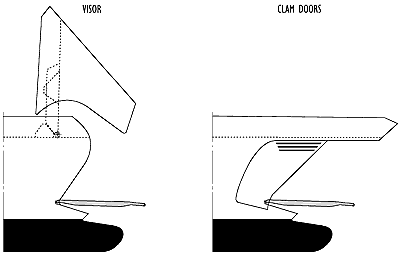
Figure 10.2 Ramps in stowed position.
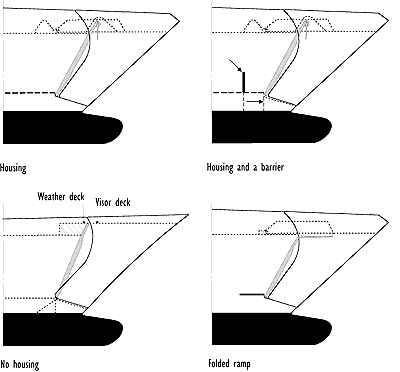
The visor concept became quite common from the 1960s. Clam doors were initially considered more complicated and before 1985 were incorporated only in a small number of ferries. Most larger ferries built since then, however, have clam doors.
 The length of the ramp was determined by the distance to the landing on the jetty and the position of the hinges. The position of the hinge point was in turn determined by the desire to have the ramp serve as an upper collision bulkhead. The SOLAS requirement on ramp position with regard to the rules for an upper extension of the collision bulkhead was, however, often disregarded. The history of compliance with this requirement is covered in Chapter 18. The length of the ramp was determined by the distance to the landing on the jetty and the position of the hinges. The position of the hinge point was in turn determined by the desire to have the ramp serve as an upper collision bulkhead. The SOLAS requirement on ramp position with regard to the rules for an upper extension of the collision bulkhead was, however, often disregarded. The history of compliance with this requirement is covered in Chapter 18.
 The available deck height was often too low to allow the ramp to be raised to a closed position. The solutions developed were then either to let the ramp protrude above weather deck level and be enclosed in a housing, or to divide the ramp into two sections with a hinge arrangement in between. The visor housing arrangement was less complicated and was generally selected. It had, however, the disadvantage that the visor and the ramp were then mechanically interconnected, a major disadvantage that was only fully realised as a consequence of the ESTONIA accident. The available deck height was often too low to allow the ramp to be raised to a closed position. The solutions developed were then either to let the ramp protrude above weather deck level and be enclosed in a housing, or to divide the ramp into two sections with a hinge arrangement in between. The visor housing arrangement was less complicated and was generally selected. It had, however, the disadvantage that the visor and the ramp were then mechanically interconnected, a major disadvantage that was only fully realised as a consequence of the ESTONIA accident.
 Clam doors, serving as the outer enclosure, have the advantage that sea loads are absorbed into the ship's structure. Although damage to clam doors has been recorded it has therefore very seldom been of a critical nature. Clam doors, serving as the outer enclosure, have the advantage that sea loads are absorbed into the ship's structure. Although damage to clam doors has been recorded it has therefore very seldom been of a critical nature.
 Visors on the other hand may under unfavourable sea conditions be exposed to sea loads in the opening direction. This has resulted in several cases in the visor moving to more or less open position (see chapter 11). Where the visor accommodates the top of the ramp, the risk is imminent that the ramp will be forced open, if the visor attachments fail totally and the visor falls off. In such a case, if the vessel has no watertight doors aft of the ramp, water will be free to enter the car deck as was the case in the ESTONIA accident. Visors on the other hand may under unfavourable sea conditions be exposed to sea loads in the opening direction. This has resulted in several cases in the visor moving to more or less open position (see chapter 11). Where the visor accommodates the top of the ramp, the risk is imminent that the ramp will be forced open, if the visor attachments fail totally and the visor falls off. In such a case, if the vessel has no watertight doors aft of the ramp, water will be free to enter the car deck as was the case in the ESTONIA accident.
 Table 10.2 gives an overview of the ferries placed into service on the route by Silja Line and Viking Line between 1959 and 1993 with the type of original bow enclosure and ramp stowage solution selected in each case. Side doors and stern ramps are not mentioned. Table 10.2 gives an overview of the ferries placed into service on the route by Silja Line and Viking Line between 1959 and 1993 with the type of original bow enclosure and ramp stowage solution selected in each case. Side doors and stern ramps are not mentioned.
Table 10.2 Original bow arrangements.
| Silja Line | Year | Viking Line |
| Birger Jarl | 1959 | (Viking, Slite) |
| Bore | 1960 | - |
| Skandia VI | 1961 | (Boge) |
| Nordia VI, Svea Jarl | 1962 | - |
| Floria | 1963 | (Ålandsfärjan, Panny R) |
| Ilmatar | 1964 | Apollo VI, (Drotten) |
| (Holmia VI) | 1965 | - |
| Fennia VI | 1966 | - |
| Botnia VI | 1967 | Kapella VI, (Visby VI) |
| - | 1968 | (Viking 2 VI) |
| - | 1969 | - |
| Floria VI | 1970 | Apollo VR, Viking 1 VR, Marella VI |
| - | 1971 | - |
| Aallotar CD, Svea Regina CD | 1972 | Viking 3 VR, Diana VR |
| Bore I VR | 1973 | Viking 4 VR, Aurella VR |
| - | 1974 | Viking 5 VR, (Viking 6 VI) |
| Svea Corona VI, Wellamo VI, Bore Star VI | 1975 | - |
| - | 1976 | (Apollo III) |
| - | 1977 | (Ålandsfärjan VI) |
| - | 1978 | - |
| - | 1979 | Diana II VR, Turella VRB |
| - | 1980 | Rosella VRB, Viking Song VI, Viking Sally VR, Viking Saga VI |
| Finlandia VRB, Silvia Regina VRB | 1981 | - |
| - | 1982 | (Aurella VI, Ålandsfärjan VR) |
| - | 1983 | (Ålandsfärjan VR) |
| - | 1984 | (Ålandsfärjan VR) |
| Svea CD | 1985 | Mariella VRB, (Ålandsfärjan VI) |
| Wellamo CD | 1986 | Olympia VRB |
| - | 1987 | (Ålandsfärjan VI) |
| - | 1988 | Amorella CD |
| - | 1989 | Athena CD, Cinderella CD, Isabella CD |
| Silja Serenade CD | 1990 | Kalypso CD |
| Silja Symphony CD | 1991 | - |
| - | 1992 | - |
| Silja Europa CD, Silja Scandinavia CD | 1993 | - |
Notes
Ships in brackets ( ) not purpose-built for the service.
R = Ramp as outer bow enclosure.
CD = Clam Doors.
VI = Independent Visor. No housing for accommodating top of ramp.
VR = Visor and box-like housing for stowing ramp.
VRB = Visor and box-like housing for stowing ramp and a separate barrier.
|
 |
 |
Ferry operation between Tallinn and Stockholm was initiated in 1989 while Estonia was still an incorporated region within the Soviet Union. The endeavour to re-establish regular vessel traffic between Estonia and Sweden resulted in signing a General Agreement between the Estonian Transport Committee and Nordström & Thulin AB on 28 August 1989.
 The Agreement provided the basis for starting joint ferry operations, including the principles for the necessary investment in related infrastructure. It was stipulated that the Estonian side would undertake the reconstruction of the terminal in Tallinn and Nordström & Thulin would undertake to provide a terminal in Stockholm. The agreement provided that the Estline Marine Company Limited would be granted the concession for operating the ferry line for the first ten years. The Agreement provided the basis for starting joint ferry operations, including the principles for the necessary investment in related infrastructure. It was stipulated that the Estonian side would undertake the reconstruction of the terminal in Tallinn and Nordström & Thulin would undertake to provide a terminal in Stockholm. The agreement provided that the Estline Marine Company Limited would be granted the concession for operating the ferry line for the first ten years.
 For the joint undertaking on the Estonian side, Estline Eesti was established in November 1989 by the transport enterprises which were under Estonian jurisdiction. In October 1992, under the conditions of regained independence, the Government of Estonia re-formed the enterprise into the company E-Line Limited and appointed the Estonian Shipping Company (ESCO) to represent the state in operating the Tallinn - Stockholm services. The decision was made with reference to the General Agreement mentioned above. For the joint undertaking on the Estonian side, Estline Eesti was established in November 1989 by the transport enterprises which were under Estonian jurisdiction. In October 1992, under the conditions of regained independence, the Government of Estonia re-formed the enterprise into the company E-Line Limited and appointed the Estonian Shipping Company (ESCO) to represent the state in operating the Tallinn - Stockholm services. The decision was made with reference to the General Agreement mentioned above.
 Regular ferry service on the route started on 17 June 1990 and was carried out by N&T EstLine AB, a fully-owned subsidiary of Nordström & Thulin AB, in co-operation with a consortium of smaller tourist-related Estonian-government-owned companies. The traffic was carried in the NORD ESTONIA, a ro-ro passenger ferry with capacity for 1060 passengers, owned by Nordström & Thulin and registered in Sweden. The vessel was operated and manned by N&T EstLine AB. The NORD ESTONIA departed every second day from Tallinn and Stockholm respectively. Regular ferry service on the route started on 17 June 1990 and was carried out by N&T EstLine AB, a fully-owned subsidiary of Nordström & Thulin AB, in co-operation with a consortium of smaller tourist-related Estonian-government-owned companies. The traffic was carried in the NORD ESTONIA, a ro-ro passenger ferry with capacity for 1060 passengers, owned by Nordström & Thulin and registered in Sweden. The vessel was operated and manned by N&T EstLine AB. The NORD ESTONIA departed every second day from Tallinn and Stockholm respectively.
 The ferry line was considered to be of the greatest importance to Estonia. Its establishment was opening the country westwards and giving opportunities to establish commercial as well as other relations with other countries, an essential factor in creating new prospects for the country. The ferry line was considered to be of the greatest importance to Estonia. Its establishment was opening the country westwards and giving opportunities to establish commercial as well as other relations with other countries, an essential factor in creating new prospects for the country.
 Traffic was maintained by the NORD ESTONIA for about two and a half years, until she was replaced by the ESTONIA on 1 February 1993. Traffic was maintained by the NORD ESTONIA for about two and a half years, until she was replaced by the ESTONIA on 1 February 1993.
 On 22 September 1994 the passenger ferry DIANA II (see 3.1.1.) was bare-boat-chartered by ESCO. The purpose was to expand the ferry service between Tallinn and Stockholm with one daily departure in each direction. This did not come about, however, due to the ESTONIA accident. On 22 September 1994 the passenger ferry DIANA II (see 3.1.1.) was bare-boat-chartered by ESCO. The purpose was to expand the ferry service between Tallinn and Stockholm with one daily departure in each direction. This did not come about, however, due to the ESTONIA accident.
 The DIANA II, after considerable upgrading including permanent closure of the bow visor and forward ramp, was put into service in November 1994 under the name of MARE BALTICUM. In August 1996 she was replaced by the REGINA BALTICA. The DIANA II, after considerable upgrading including permanent closure of the bow visor and forward ramp, was put into service in November 1994 under the name of MARE BALTICUM. In August 1996 she was replaced by the REGINA BALTICA. |
 |


